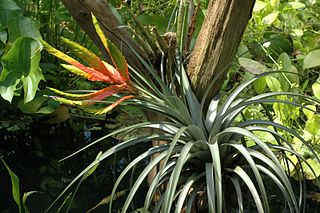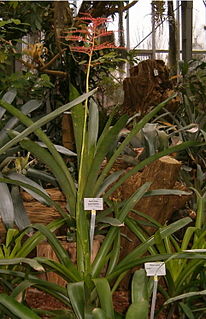
The Bromeliaceae is a family of monocot flowering plants of 75 genera and around 3590 known species native mainly to the tropical Americas, with several species found in the American subtropics and one in tropical west Africa, Pitcairnia feliciana.

Spanish moss is an epiphytic flowering plant that often grows upon large trees in tropical and subtropical climates. It is native to much of Mexico, Bermuda, the Bahamas, Central America, South America, the Southern United States, and West Indies. It has been naturalized in Queensland (Australia). It is known as "grandpa's beard" in French Polynesia.

Werauhia is a genus of the botanical family Bromeliaceae, subfamily Tillandsioideae. The genus is named for Werner Rauh, a German botanist (1913–2000). Based on molecular evidence, a number of species previously classified within other bromeliad genera, especially Vriesea and Tillandsia, have been placed in Werauhia instead.

Vriesea is a genus of flowering plants in the botanical family Bromeliaceae, subfamily Tillandsioideae. The genus name is for Willem Hendrik de Vriese, Dutch botanist, physician (1806–1862). Its species are widespread over Mexico, Central America, South America and the West Indies.

Tillandsioideae is a subfamily of plants in the bromeliad family Bromeliaceae. This subfamily contains the greatest number of species. Most are epiphytic or lithophytic, growing in trees or on rocks where they absorb water and nutrients from the air. Spanish moss of the genus Tillandsia is a well-known species. Bromeliads in the genera Guzmania and Vriesea are the more commonly cultivated members of this subfamily.

Pitcairnia is a genus of plants in the family Bromeliaceae, subfamily Pitcairnioideae. It was named for William Pitcairn, Scottish physician and gardener (1711–1791). The genus Pitcairnia ranks as the second most prolific of the bromeliad family. They are most abundant in Colombia, Peru and Brazil, but can also be found in areas from Cuba and Mexico south to Argentina. One species, Pitcairnia feliciana, is found in tropical West Africa and is the only member of the family Bromeliaceae not native to the Americas.

Racinaea is a genus of the flowering plants in the family Bromeliaceae, subfamily Tillandsioideae. The genus is named for Racine Foster, wife of Mulford B. Foster and co-founder of the BSI.
Lemeltonia acosta-solisii is a species of plant in the family Bromeliaceae. It is endemic to Ecuador. Its natural habitats are subtropical or tropical moist lowland forests and subtropical or tropical moist montane forests. It is threatened by habitat loss.

Racinaea dyeriana is a species of plant in the family Bromeliaceae. It is endemic to Ecuador. Its natural habitat is subtropical or tropical mangrove forests. It is threatened by habitat loss.

Wallisia pretiosa is a species of plant in the family Bromeliaceae. It is endemic to Ecuador. Its natural habitats are subtropical or tropical moist lowland forests and subtropical or tropical moist montane forests.
Tillandsia walter-tillii is a species of flowering plant in the family Bromeliaceae, endemic to Ecuador. Its natural habitat is subtropical or tropical moist montane forests. It is threatened by habitat loss. It was first described by José Manuel Manzanares in 1998 as Vriesia tillii. When Jason Randall Grant transferred it to the genus Tillandsia in 2004, the epithet had to be changed because the combination Tillandsia tillii was already in use for a different species. Tillandsia walter-tillii is a replacement name.

Tillandsia subg. Anoplophytum is a subgenus of the genus Tillandsia.

Pseudalcantarea viridiflora is a species of flowering plant in the family Bromeliaceae, native to Mexico and Central America. It was first described by Johann Georg Beer in 1856.
Tillandsia malzinei is a species of flowering plant in the family Bromeliaceae, native to Mexico. It was first described by Charles Jacques Édouard Morren in 1874 as Vriesea malzinei.
Tillandsia chontalensis, synonym Vriesea chontalensis, is a species of flowering plant in the family Bromeliaceae, native from Central America to Colombia, north west Ecuador and west Bolivia. It was first described by John Gilbert Baker in 1887.
Tillandsia heterandra, synonym Vriesea heterandra, is a species of flowering plant in the family Bromeliaceae, native to north-west South America. It was first described by Édouard André in 1888.
Barfussia platyrhachis is a species of flowering plant in the genus Barfussia. This species is native to Colombia, Peru, and Ecuador.

Tillandsia subg. Tillandsia is a subgenus of the genus Tillandsia.
Tillandsia subg. Pseudovriesea is a subgenus of the genus Tillandsia.












